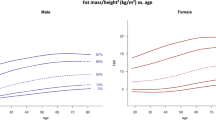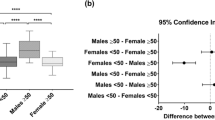Abstract
The objective of this study was to explore the accuracy of summing multiple dual-energy X-ray absorptiometry (DXA) scans to estimate whole-body soft tissue measures and the sarcopenic index in female subjects for application to an obese population. Forty-five women who fit within the DXA scanning region (M±s.d.; BMI=24.5±4.6 kg/m2) were scanned four times (one normal whole body (WB) scan, one head/trunk/leg scan allowing trunk delineation (TRK–H–L), one scan with body shifted right (LA) and one left (RA) to allow arm delineation). Fat mass (FM) and appendicular lean mass were determined from the WB scan (aLMWB), with the latter determined by summing arm and leg mineral-free lean mass (MFLM). Strong agreement and no differences (M±s.d.DIFF) were found between FMWB and FMSUM (–0.12±0.38 kg, P=0.37; r=0.999, P<0.001); MFLMWB and MFLMSUM (0.02±0.36 kg, P=0.80; r=0.998, P<0.001); and aLMWB and aLMSUM (0.12±0.32 kg, P=0.63; r=0.994, P<0.001). Summing DXA scans is a valid method for determining the risk for sarcopenic obesity and may aid research regarding obesity and risk for disability.
This is a preview of subscription content, access via your institution
Access options
Subscribe to this journal
Receive 12 print issues and online access
$259.00 per year
only $21.58 per issue
Buy this article
- Purchase on Springer Link
- Instant access to full article PDF
Prices may be subject to local taxes which are calculated during checkout

Similar content being viewed by others
References
Albanese CV, Diessel E, Genant HK (2003). Clinical applications of body composition measurements using DXA. J Clin Dens 6, 75–85.
Altman DG, Bland JM (1983). Measurement in medicine: the analysis of method comparison studies. Statistician 32, 307–317.
Baumgartner RN, Wayne SJ, Water DL, Janssen I, Gallagher D, Morley JE (2004). Sarcopenic obesity predicts instrumental activities of daily living disability in the elderly. Obes Res 12, 1995–2004.
Blake GM, Wahner HW, Fogelman I (1999). Commercial instruments for spine, femur, and total-body DXA. In: Dunitz M (ed) The Evaluation of Osteoporosis: Dual Energy X-ray Absorptiometry and Ultrasound in Clinical Practice 2nd edn. pp 73–88. Blackwell Science: Malden.
Bland JM, Altman DG (1986). Statistical methods for assessing agreement between two methods of clinical measurement. Lancet (London) 1, 307–310.
Cordero-MacIntyre ZR, Peters W, Libanati CR, Espana RC, Abila SO, Howell WH et al. (2002). Reproducibility of DXA in obese women. J Clin Dens 5, 35–44.
Newman AB, Kupelian V, Visser M, Simonsick E, Goodpaster BH, Nevitt M et al. (2003). Sarcopenia: alternative definitions and associations with lower extremity function. J Am Ger Soc 51, 1602–1609.
Rothney MP, Brychta RJ, Schaefer EV, Chen KY, Skarulis MC (2009). Body composition measured by dual-energy X-ray absorptiometry half-body scans in obese adults. Obesity (Silver Spring) 17, 1281–1286.
Villareal DT, Banks M, Siner C, Sinacore D, Klein S (2004). Physical frailty and body composition in obese elderly men and women. ObesRes 12, 913–920.
Zamboni M, Mazzali G, Zoico E, Harris TB, Meigs JB, Di Francesco V et al. (2005). Health consequences of obesity in the elderly: a review of four unresolved questions. Int J Obes 29, 1011–1029.
Author information
Authors and Affiliations
Corresponding author
Additional information
Contributors: EME designed the experiment, analyzed the data and wrote the manuscript. MMM also designed the experiment, collected the data, cleaned the data set and edited the manuscript. DMM collected the data and managed the data set.
Rights and permissions
About this article
Cite this article
Evans, E., Misic, M. & Mallard, D. A technique to assess body composition and sarcopenia using DXA: application for an obese population. Eur J Clin Nutr 64, 218–220 (2010). https://doi.org/10.1038/ejcn.2009.128
Received:
Revised:
Accepted:
Published:
Issue Date:
DOI: https://doi.org/10.1038/ejcn.2009.128



